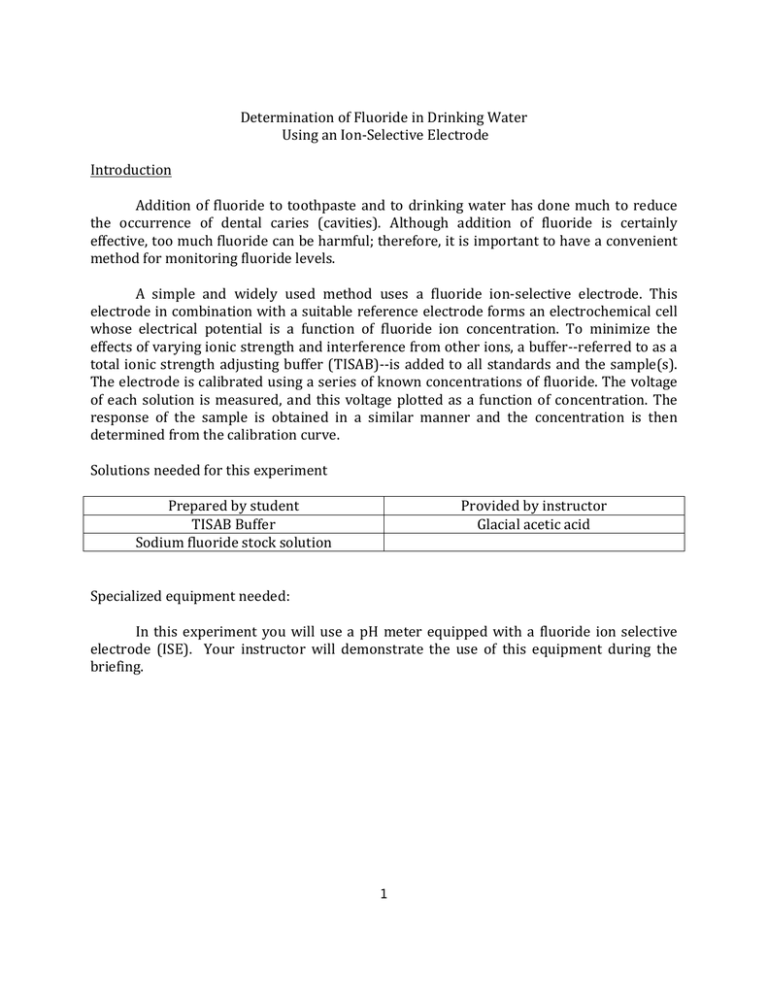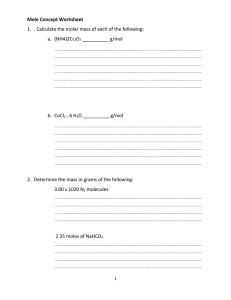Document 12269975
advertisement

Determination of Fluoride in Drinking Water Using an Ion-­‐Selective Electrode Introduction Addition of fluoride to toothpaste and to drinking water has done much to reduce the occurrence of dental caries (cavities). Although addition of fluoride is certainly effective, too much fluoride can be harmful; therefore, it is important to have a convenient method for monitoring fluoride levels. A simple and widely used method uses a fluoride ion-­‐selective electrode. This electrode in combination with a suitable reference electrode forms an electrochemical cell whose electrical potential is a function of fluoride ion concentration. To minimize the effects of varying ionic strength and interference from other ions, a buffer-­‐-­‐referred to as a total ionic strength adjusting buffer (TISAB)-­‐-­‐is added to all standards and the sample(s). The electrode is calibrated using a series of known concentrations of fluoride. The voltage of each solution is measured, and this voltage plotted as a function of concentration. The response of the sample is obtained in a similar manner and the concentration is then determined from the calibration curve. Solutions needed for this experiment Prepared by student Provided by instructor TISAB Buffer Glacial acetic acid Sodium fluoride stock solution Specialized equipment needed: In this experiment you will use a pH meter equipped with a fluoride ion selective electrode (ISE). Your instructor will demonstrate the use of this equipment during the briefing. 1 Experimental Procedure Preparation of reagents and stock solution 1. Buffer solution, pH 5.0-­‐5.5: To approximately 500 mL of distilled water in a 1-­‐liter beaker add 14 mL of glacial acetic acid, 58 g of sodium chloride, 61.6 g sodium acetate, and 0.29 g sodium citrate. Stir to dissolve and cool to room temperature. Check the pH of this solution, and if not close to pH 5, adjust using small amounts of acetic acid or 0.1 M sodium hydroxide (as needed). Transfer solution to a 1-­‐liter volumetric flask and dilute to the mark with distilled water. A group of students may share this buffer. 2. Sodium fluoride, stock solution: 1.0 mL= 0.1 mg F. Dissolve 0.2210 g of sodium fluoride in distilled water and dilute to 1 liter in a volumetric flask. Store in a polyethylene bottle. The sodium fluoride should be dried about four hours at 120 oC then cooled to room temperature in a desiccator before weighing. Preparation of calibration standards and unknown. 1. Prepare a series of at least five calibration standards covering the range of 0.1 mg/L F-­‐ to 10 mg/L by pipetting appropriate amounts of the fluoride stock solution into 100.00 mL volumetric flasks. Add 50 mL of the TISAB solution, then dilute to the mark with deionized water. Unless the standards are immediately analyzed, store in polyethylene containers. NOTE: not all of these standards can be made in one single dilution. You may need to make an intermediate concentration of fluoride, from which your calibration standard can be prepared. This process is described as “serial dilution”. 2. Pipet 25.00 mL of the unknown into a 50.00 mL volumetric flask and dilute to the mark with TISAB. If it is necessary to store the sample transfer it to a polyethylene container. 3. If necessary, fill the reference electrode with the proper filling solution and attach the electrode to the meter. Remove the cap from the fluoride electrode, rinse it with deionized water and connect it to the meter. Dry both electrodes carefully with a tissue. 4. Place enough of the solution to be measured in a plastic beaker so that the solution will cover about 1 cm of the tip of the electrodes, with enough space between the electrode and the bottom of the beaker for a magnetic stirring bar. Carefully place a magnetic stirring bar in the beaker and place the beaker on a magnetic stirrer. Lower the electrodes into the solution and set the stirrer for moderate stirring. Make sure that the stirring bar will not strike the electrodes before starting the stirrer. 2 5. 6. Set the meter to read relative millivolts. Allow the reading to stabilize for five minutes, and then take a reading to the maximum precision of the scale. Particularly with the very low concentrations the voltage may drift slowly for some time. Taking the reading at the end of five minutes has been found to give consistent results provided all solutions are read after the same amount of time for equilibration. After measuring all of the calibration solutions and the sample(s), prepare a calibration curve by plotting the relative mV vs. the log of the concentration of the standards. Read the concentration of the unknown sample from the calibration curve. From this data calculate the mg/L (ppm) fluoride ion in the water sample. Laboratory report. A sample report is included at the end of this procedure. You must turn in your calibration curve with this experiment. WASTE DISPOSAL: All solutions can be poured down the sink. 3 Fluoride by Ion Selective Electrode Name: Alfred E. Neumann Unknown number: √ -­‐1 Concentration, mg/L Log concentration Relative millivolts 0.100 -­‐1.000 1747 2.00 0.301 1724 5.00 0.699 1716 7.00 0.845 1714 10.00 1.0000 1711 Unknown 1729 NOTE: S.F.!!!! Calibration curve: attached. Slope = -­‐18.025 Intercept = 1729.1 Unknown: 1729 = 1729.1 – 18.025[x] [x] = 0.00555 (NOTE: S.F. !!!!) [F-­‐]sample = 100.00555 = 1.01 mg/L (NOTE: S.F. !!!!) [F-­‐]unknown = 1.01 mg/L x (50.00mL/25.00mL) = 2.02 mg/L 4





